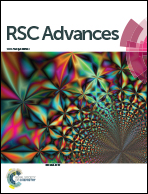Label-free electrochemiluminescent detection of transcription factors with hybridization chain reaction amplification†
Abstract
Because of the intrinsic importance of transcription factors (TFs) as targets in clinical diagnosis and drug development, the simple and sensitive detection of TFs is very essential for biological studies and medical diagnostics. However, most of the reported methods involve complicated operations or labelling processes and in addition, an electrochemiluminescence (ECL) method with various distinct advantages hasn't been developed for TF detection until now. In this work, we describe a novel simple and efficient strategy for label-free ECL detection of transcription factors with hybridization chain reaction (HCR) signal amplification. Based on the Ag+-stabilized self-assembly triplex DNA, in the presence of TFs, TFs specifically bond to the duplex DNA (dsDNA) recognition probes, resulting in the separation of target DNA from the triplex structure. With the SH-capture probe DNA assembled gold electrode, the presence of the target DNA and helper DNA-1 and helper DNA-2 leads to the formation of long chain dsDNA polymers on the gold electrode surface through hybridization chain reaction, which allows the intercalation of numerous ECL indicators Ru(phen)32+ (phen = 1,10-phenanthroline) into the dsDNA grooves, resulting in significantly amplified ECL signal output. The proposed strategy combines the amplification power of the HCR and the inherent high sensitivity of the ECL technique, resulting in the sensitive detection of transcription factors with a detection limit of as low as 0.017 nM and a broad dynamic range from 0.05 to 2 nM. The distinct advantage of the method is that it is label-free, has high sensitivity and requires no separation of the signal generation strand, which boosts the potential application for real sample detection.


 Please wait while we load your content...
Please wait while we load your content...